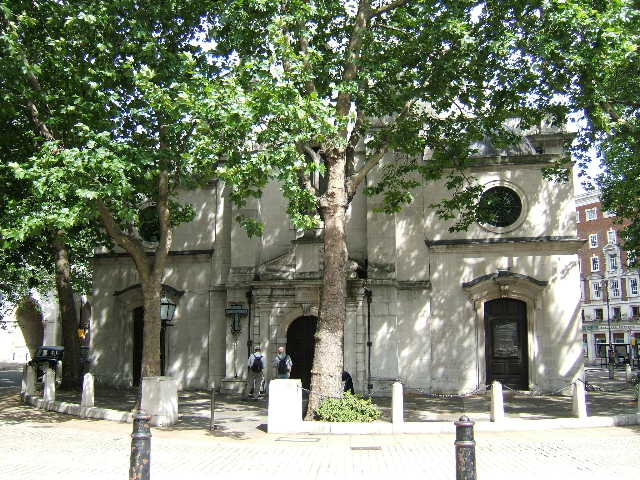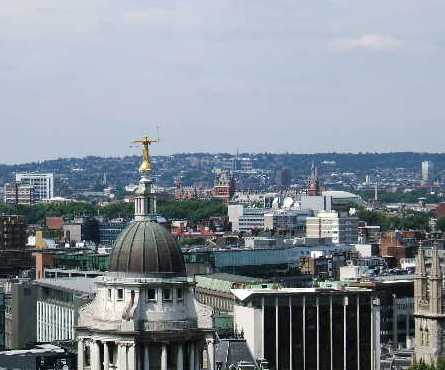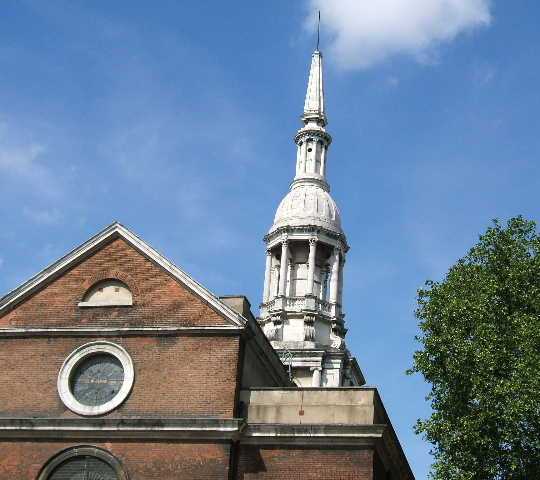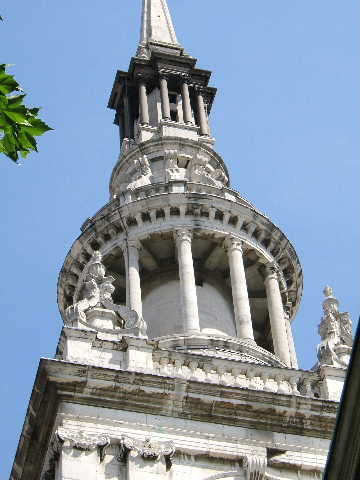by Esmerelda Weatherwax (Sept 2006)
Following on from last months meandering among the more popular nursery rhymes, this rhyme is a personal favourite, featuring as it does London Churches, many still standing, and several of which have an important place in my family’s history. The usual version is this.
“
“You owe me five farthings” say the Bells of St Martin’s
“When will you pay me?” say the Bells of Old Bailey
“When I grow rich” say the Bells of Shoreditch
“When will that be?” say the Bells of Stepney
“I do not know” say the Great Bells of Bow
“Here comes a Candle to light you to Bed
Here comes a Chopper to Chop off your Head
Chip chop chip chop – the Last Man's Dead.”
When I did a bit of research, to confirm whether certain things I believed were true, and to explore other explanations, I discovered that this is not the earliest version, but that the rhyme below, which I was not familiar with, is even older.
Gay go up and gay go down
To Ring the Bells of London Town
“Oranges and Lemons” say the Bells of St Clement’s
“Bullseyes and Targets” say the Bells of St Margaret’s
“Brickbats and Tiles” say the Bells of St Giles
“Halfpence and Farthings” say the Bells of St Martins
“Pancakes and Fritters” say the Bells of St Peters
“Two Sticks and an Apple” say the Bells of Whitechapel
“Maids in white aprons” say the Bells at St Katherine’s
“Pokers and Tongs” say the Bells of St John’s
“Kettles and Pans” say the Bells of St Anne’s
“Old Father Baldpate” say the Slow Bells of Aldgate
“You owe me Ten Shillings” say the Bells of St Helen’s
“When will you Pay me?” say the Bells of Old Bailey
“When I grow Rich” say the Bells of Shoreditch
“Pray when will that be?” say the Bells of Stepney
“I do not know” says the Great Bell of Bow.
Gay go up and gay go down
To Ring the Bells of London Town
The earlier rhyme features many of the trades and skills of
Back to the familiar version. This is as good a description of how to play the game as I have come across.
Two children become the 'chopper' by holding hands and forming an arch. They secretly decide which one of them is '
 The other children go through the arch in a line, circling round behind the arch, and going through again, singing the rhyme as they go. At the last line of the rhyme the 'choppers' bring their arms up and down in a chopping motion over each child that goes through. The game can get quite nerve-racking for the children at this point, and they often run through as fast as they can. The child caught in the middle at the last word of the rhyme is out. The captured child secretly chooses to be
The other children go through the arch in a line, circling round behind the arch, and going through again, singing the rhyme as they go. At the last line of the rhyme the 'choppers' bring their arms up and down in a chopping motion over each child that goes through. The game can get quite nerve-racking for the children at this point, and they often run through as fast as they can. The child caught in the middle at the last word of the rhyme is out. The captured child secretly chooses to be
St Clements’s church may be the one in St Clement’s Lane Eastcheap where fruit was unloaded from nearby wharfs. But some authorities say that it is the better known St Clement Danes in the  Pictured above.
Pictured above.
I had always believed
The Bells of Shoreditch are the peal of  baptized and married over the last 200 years. My late father worked nearby, and worked on the rewiring when some repair work was done 40 years ago. There has been more restoration since and a major project is on going. Shakespeare knew an earlier church on the site when he worked at the Curtain Theatre in what is now
baptized and married over the last 200 years. My late father worked nearby, and worked on the rewiring when some repair work was done 40 years ago. There has been more restoration since and a major project is on going. Shakespeare knew an earlier church on the site when he worked at the Curtain Theatre in what is now
The bells of Stepney may be those of St Dunstans, which were made in the Whitechapel Bell foundry, or they may be those in the foundry itself. The foundry is one of two places in
The Great Bell of Bow is that of St Mary le Bow in  definition of a cockney is given, ie that we are someone born within the sound of Bow bells. The bells are a bit muffled these days, and their sound doesn’t carry far over the noise of
definition of a cockney is given, ie that we are someone born within the sound of Bow bells. The bells are a bit muffled these days, and their sound doesn’t carry far over the noise of
In recent times the rhyme has given its name to a drink. A St Clements is a mixture of orange juice and bitter lemon, popular in pubs with drivers and the very young.
And finally, from the Diocese of Oxford is a recipe for September’s St Clement’s Cake. Yum.
Photos by Mistrum Ridcully.
To comment on this article click here.
If you enjoyed this piece and would like to read more by Esmerelda Weatherwax, please click here.
Esmerelda Weatherwax is a regular contributor to the Iconoclast, our community blog. To view her entries please click here.
- Like
- Digg
- Tumblr
- VKontakte
- Buffer
- Love This
- Odnoklassniki
- Meneame
- Blogger
- Amazon
- Yahoo Mail
- Gmail
- AOL
- Newsvine
- HackerNews
- Evernote
- MySpace
- Mail.ru
- Viadeo
- Line
- Comments
- SMS
- Viber
- Telegram
- Subscribe
- Skype
- Facebook Messenger
- Kakao
- LiveJournal
- Yammer
- Edgar
- Fintel
- Mix
- Instapaper
- Copy Link






